

| ACTIVE PROJECTS
|
filed by Dr. Craig Lee on 10 June 2003
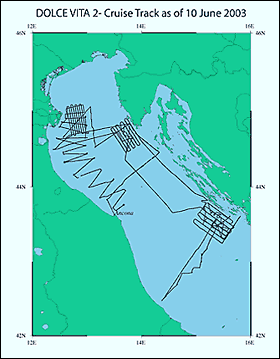 |
|||
Figure 1. Cruise tracks as of 10 June 2003. | |||
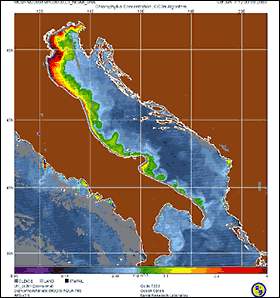 |
|||
Figure 2. A MODIS ocean color image (provided by NRL- Stennis Space Center) from 7 June 2003.
| |||
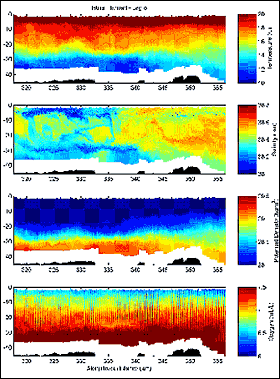 |
|||
Figure 3. A section across the Istria front, running north to south. Data have not been lag-corrected, and hysteresis (SP?) is thus apparent in all sensors. Note the strong salinity front and the numerous small-scale interleaving features. | |||
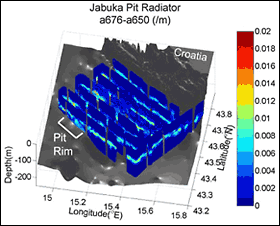 |
|||
Figure 4. A curtain plot of the difference between optical absorption at 676 nm and 650 nm during the first Jabuka radiator in the region of the Mid-Adriatic Filament. This difference is correlated with chlorophyll concentration. Most obvious is the subsurface maximum present throughout the region at 75 meters depth. Significant horizontal patchiness also exist in this layer. At the northern rim of the Pit, the chlorophyll maximum becomes diffuse and reorganizes north of the rim. | |||
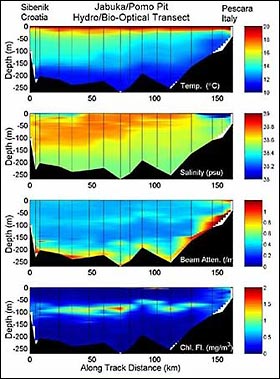 |
|||
Figure 5. A curtain plot of optical attenuation at 650 nm in the Po River plume. The viewing perspective is looking from the Italian toward Istria, Croatia. At the surface there is a thin layer of high attenuation indicative of high levels of suspended particulate material. This layer thins, narrows and decreases in attenuation progressing offshore. Also, in the first leg near the center of the leg, particles can be seen beneath the surface layer, apparently falling from the surface. | |||
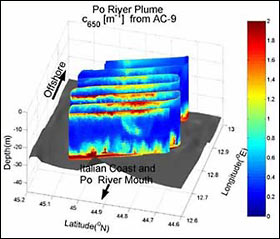 |
|||
Figure 6. The hydrographic section showing temperature, salinity, beam attenuation and chlorophyll fluorescence extending from near the Croatian town of Sibenik westward toward the Italian town of Pescara. As in Figure 4, the subsurface chlorophyll maximum is pronounced. The influence of the Po River plume can be seen in the low salinity, high chlorophyll near surface band near the Italian coast. | |||
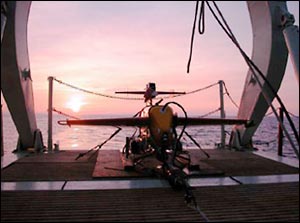 | ||
Sunrise in the Adriatic. | ||
We began with a couple of sections across the northern basin to shake out the various instruments and to scout the 'Istria front' (Figure 2). Remotely sensed SST provides little information this time of year, as the entire basin is surface capped. Ocean color is a bit better, though the Po plume dominates the variability. The April/May SACLANTCEN/NRL cruise found a subsurface front at the same location where we observed the 'Istria front' last winter, though the feature was considerably weaker. We observed a weak front in this region (Figure 3), probably formed by a filament of cooler water extending from Kvarner Bay.
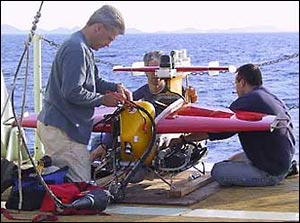 | ||
Tim McGinnis, Eric Boget and Jason Gobat preparing TriSoarus for deployment. | ||
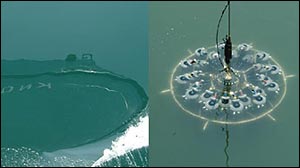 | ||
A contrast in surface waters—on the eastern side of the basin, clear, blue water and near the Po delta (western side) surface waters were green and murky, a combination of high phytoplankton content and suspended inorganic material. | ||
Over the past few days, we've been working at the mouth of the Po, studying the outflow region during a period of weak discharge. Sampling has included two orthogonally-oriented TriSoarus surveys and an intensive daytime section of CTDs and optical profiles. The attenuation at 650 nm from the first Po survey is shown in Figure 5. Next, we intend to run an extended pattern, executing cross-shelf TriSoarus sections between the Po Delta and the Jabuka Pit. During this period, we will choose an instability somewhere along the Po plume (the best candidate at this time is a pair of filaments extending over the Jabuka Pit) for a final, focused three-day study.